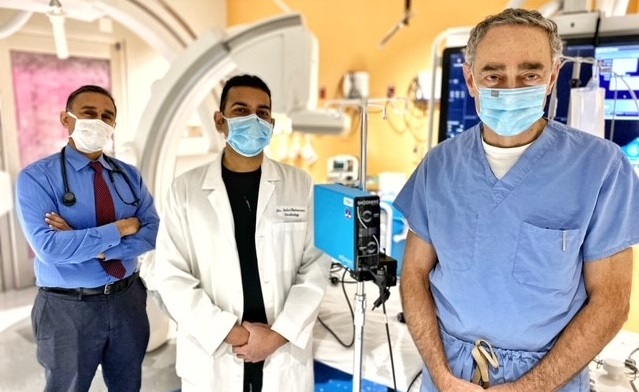Innovative “Shockwave” Technology Gives New Hope to Crouse Health Patients with Heart Disease
January 11, 2022
Home » News » Innovative “Shockwave” Technology Gives New Hope to Crouse Health Patients with Heart Disease

Crouse Medical Practice interventional cardiologists (l-r) Anil George, MD; John Ulahannan, MD; and Joseph Battaglia, MD, are now using shockwave therapy to safely break up calcium deposits in coronary arteries.
Crouse Health is now offering patients with severely calcified coronary artery disease a new, minimally invasive treatment option that uses sonic pressure to safely break up calcium blockages that can reduce blood flow to the heart.
The shockwave technology, also known as intravascular lithotripsy or IVL, enables physicians to fracture the calcium deposits using sonic pressure waves so the artery can be safely expanded and blood flow is restored with the placement of a stent and without unnecessary complications.
As individuals with coronary artery disease age and their condition progresses, plaque in their arteries turns into calcium deposits, which can narrow or block the arteries. Physicians often use stents to open narrowed or blocked arteries to restore blood flow.
Of the approximately 1 million patients who undergo stent procedures each year, 30 percent have problematic calcium that increases their risk for serious complications. This is because the bone-like calcium deposits make the artery rigid and more difficult or impossible to reopen with conventional treatments alone. Such treatments include balloons deployed by a catheter and inflated under high pressure to break up the calcium.
In contrast, Crouse Medical Practice interventional cardiologists Joseph Battaglia, MD; Anil George, MD; and John Ulahannan, MD, use shockwave technology to insert a catheter into the artery and inflate a balloon to a low pressure. Shockwave IVL delivers sonic pressure waves that gently break up the calcium deposits in the artery wall. After the calcifications are broken up, the cardiologist expands the balloon to prepare the artery for stenting to improve blood flow.
Approved by the FDA for coronary use in 2020, Shockwave IVL historically has been used to break up kidney stones through lithotripsy, said Dr. Battaglia. This treatment has proven to be extremely safe and effective in disrupting rigid calcium deposits in coronary arteries.
“We are grateful to the Mirons for their generous and continued support of our cardiac program, which allows us to provide patients with the latest and safest innovations to treat heart disease and improve lives,” says Dr. Battaglia. Funding for the new technology was made possible by a donation from Diane and Bob Miron, longtime Crouse Health supporters and major donors to the Diane and Bob Miron Cardiac Care Center at Crouse.
